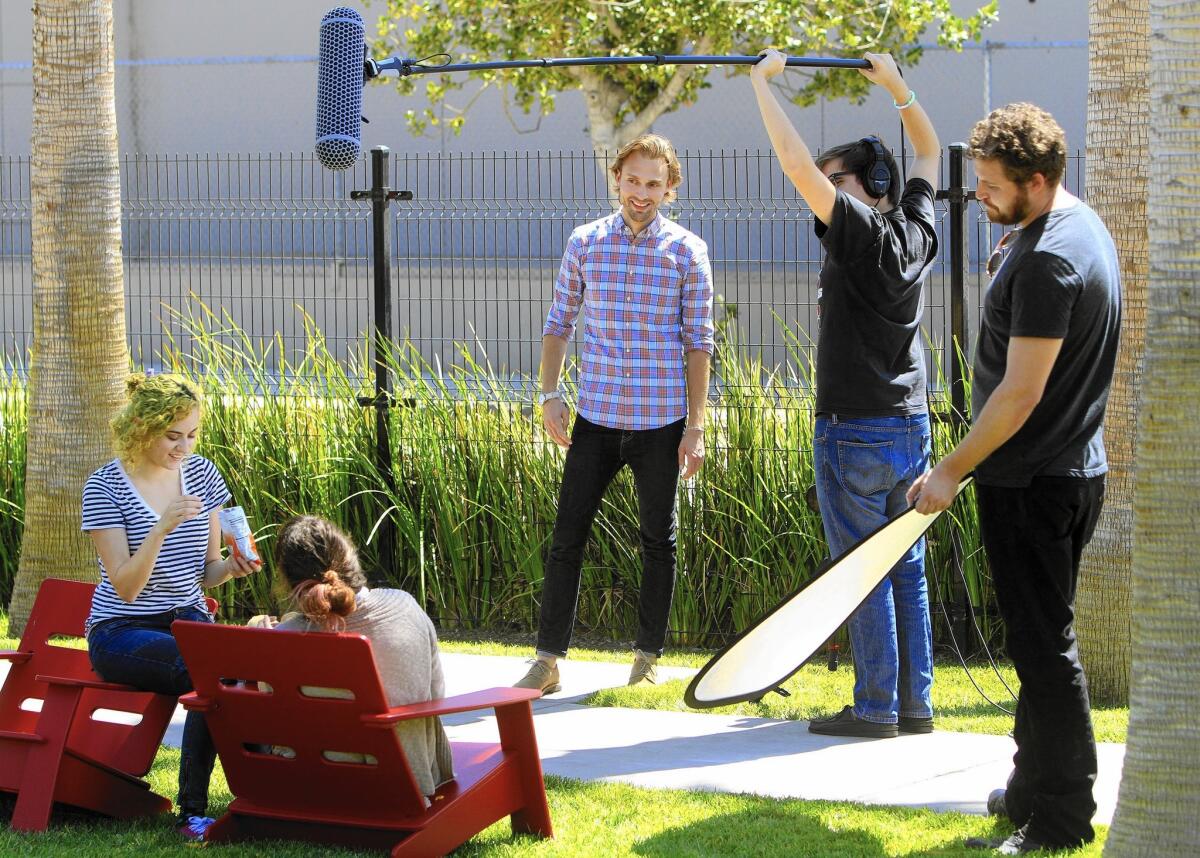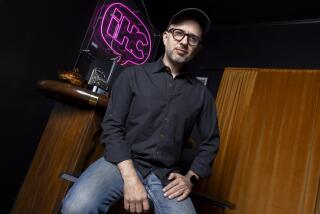BuzzFeed Motion Pictures’ winning strategy: fast, cheap and viral

The first stars to emerge from BuzzFeed’s new Hollywood studio got their big break when Kim Kardashian bared her behind on the cover of Paper magazine.
Immediately after seeing the picture, the “Try Guys” — four up-for-anything millennials — thought it would be a good idea to drink two bottles of wine and video themselves imitating the famous photograph while covered in baby oil and not much else.
The clip known as “Guys Recreate Kim Kardashian’s Butt Photo” has garnered nearly 14 million views on YouTube since its release in November, putting the “Try Guys” franchise on the digital map.
Not bad for something that took less than $300 and 24 hours to make.
SIGN UP for the free California Inc. business newsletter >>
Launched last year, BuzzFeed Motion Pictures is the video arm of the New York digital media company famous for its bite-sized listicles and quizzes. Low unit costs plus huge page views could add up to a rich stream of advertising revenue. That — and the company’s direct route into the millennial demographic — is one reason NBCUniversal is in talks to acquire a piece of the fast-growing private company.
BuzzFeed, which is also investing in foreign reporting and investigative journalism, has already evolved into one of the top video producers on the Internet with a staggering 1.5 billion monthly views.
More remarkable is how they’re doing it. The upstart West Coast studio is acting like no other Hollywood system before it — emphasizing an experimental, quick-hit approach to filmmaking with a heavy assist from data science to spread its content across the Web. “This modern crop of talent is not optimized for six-month script writing processes where they’re getting notes from someone they’ve never met and for a show that might air in a year. They just put it out there,” said Ze Frank, president of BuzzFeed Motion Pictures.
BuzzFeed’s video unit is now whipping out up to 75 original clips a week from a 4-acre lot near Sunset and Vine where a Big Lots store and a yoga studio used to sit.
BuzzFeed is cheap and fast, Frank said, because his staff can write, shoot, edit, produce and even star in their own creations. Videos, start to finish, tend to take less than a week to make.
The result: viral hits such as “If Disney Princes Were Real,” with 38 million views and counting on YouTube, and “14 Sex Facts You Won’t Believe Are True,” viewed more than 17 million times on YouTube.
Low brow? Perhaps. But Frank says that’s missing the point.
“I would never say this is the future of content,” he said. “This is the future of creating content. That’s a fairer statement.”
Experimentation is BuzzFeed Motion Pictures’ core principle. By applying rapid data analytics to performance, producers get instant feedback on which videos go viral and which fall flat — and why.
The company is backed by $100 million in venture capital. The studio’s 263 full-time employees test new formats in rapid fashion, be it with scripted and unscripted content or toying with framing videos vertically to better fit cellphone screens (BuzzFeed gets twice as many views on mobile devices as desktop computers).
A lot of stuff doesn’t work, but unpredictable patterns of popularity emerge from the chaos. One example: post-literate videos, clips that don’t require dialogue. That’s aimed at capturing a larger non-English-speaking audience and overcoming the difficulty of hearing videos in public, specifically on cellphones.
Employees are largely free to produce content as they see fit, but they’re also guided by ever-changing editorial missions such as exploring beauty and body image issues or testing whether animal videos can help people relate or communicate — also based on data feedback.
It’s all about finding subjects that resonate. But the masters of viral say success isn’t guaranteed.
“We can’t take any piece of content and make it viral. There is no sauce you can sprinkle on something and then it travels. It’s a misconception,” Frank said.
The data team can also fine-tune what works best on different online destinations by seeing how content fans out from, say, Twitter to Facebook and Pinterest like a contagion. BuzzFeed Studios then tailors content for each and charges advertisers accordingly.
“It’s not making decisions on the value of someone’s ‘gut’ instincts, which was often the way to describe the way studio titles were green-lit,” said Eunice Shin, the Los Angeles director of Manatt Digital Media, a consulting and venture capital firm. “With BuzzFeed and other savvy digital-first companies, it’s making decisions based on data and science and applying that to an intimate understanding of its audience.”
That audience, crucially, includes major advertisers. BuzzFeed isn’t just a new kind of movie studio. It’s also a new kind of ad agency. Ads are the key source of revenue.
An estimated $7.8 billion will be spent on digital video advertising this year in the U.S., double the amount from two years ago, according to EMarketer.
“For advertisers, video is very powerful. There’s just not enough of it,” said Chris Wexler, senior vice president and director of media and consumer engagement for advertising agency Cramer-Krasselt. “That imbalance means there are more buyers than sellers, and it’s the reason why BuzzFeed is doubling down on video.”
Digital publishers, including Vice, Vox and Mashable, are also investing heavily in the popular medium, rushing to fill unmet demand for content.
BuzzFeed pays the bills by syndicating its content and leaning on preview ads, sponsorships and a side business creating commercials such as Purina’s “Puppyhood” video, which has totaled 65 million views. The commercials, known as native advertising or branded content, are inspired by BuzzFeed’s library of nearly 5,000 videos created since 2012.
Friskies’ wildly popular “Dear Kitten” video (22.6 million views and counting) was based on a piece of editorial content called “Sad Cat Diary” (23.5 million views). Both feature talking cats.
Ad executives say BuzzFeed’s established brand gives it an advantage over rivals for native advertising, including Maker Studio and Fullscreen. Rather than sounding like a hard pitch, they say, BuzzFeed’s commercials typically channel the same quirky and sentimental tone that’s become a hallmark of its editorial content.
Consider a recent Toyota Camry campaign. The automaker wanted to promote the car as a “bold” vehicle. BuzzFeed, in the run-up to Father’s Day, came up with a three-minute video titled “Revelations Your Dad Is Awesome.” In it, adult children in a “Wonder Years”-like voice-over speak of their father’s adventures and accomplishments: cycling across the U.S., surviving a capsizing in rough seas. The piece aims to tug the heart strings of 20-somethings everywhere.
“BuzzFeed threads the needle by giving advertisers a voice in a manner relevant to the platform,” said Rob Norman, chief digital officer for WPP’s GroupM, the world’s largest buyer of digital advertising and the company behind BuzzFeed’s Purina ads.
Frank said that those ads are helping the studio break even financially and that it would explore longer-form content.
Michael Shamberg, producer of “Pulp Fiction” and “Django Unchained,” and comedian Jordan Peele of Comedy Central’s “Key and Peele” are both advisors to the studio.
At a recent brainstorm session, BuzzFeed producers, editors and designers examined older posts for new ideas. Conversations veered toward the plight of left-handed people and “right-handed privilege,” the power of mascara and the trick to taking the perfect picture (exhale so you look relaxed).
All of it could be fodder for the next viral splash, said Eugene Lee Yang, one of the “Try Guys,” who sat in on the meeting.
“The viral landscape is shifting and changing,” said the USC film school graduate who joined BuzzFeed in 2013 as an intern. “What keeps the job so exciting is that you always have to be connected and sensitive to people around you.”
The thrilling part of the job, however, is producing a video and watching viewership climb to nearly 40 million.
“Not going to lie,” Yang said. “It’s one of the most gratifying things ever.”
Twitter: @dhpierson
SIGN UP for the free California Inc. business newsletter >>







